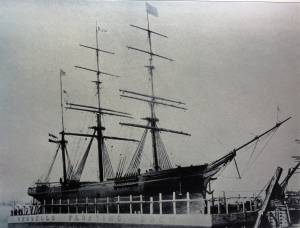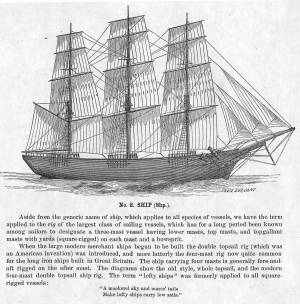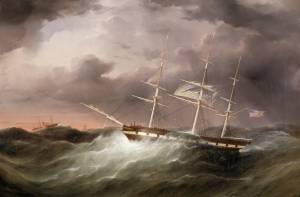An online project under the direction of the CAPE ANN MUSEUM
inv. 12
A Rough Sea
1854 Oil on canvas 24 x 36 1/4 in. (61 x 92.1 cm) 31 x 46 in. (frame) Signed, inscribed, and dated verso (in a window cut in backing board): F.H. Lane Gloucester 1854
|
Related Work in the Catalog
Explore catalog entries by keywords view all keywords »
Historical Materials
Below is historical information related to the Lane work above. To see complete information on a subject on the Historical Materials page, click on the subject name (in bold and underlined).
The term "ship," as used by nineteenth-century merchants and seamen, referred to a large three-masted sailing vessel which was square-rigged on all three masts. (1) In that same period, sailing warships of the largest classes were also called ships, or more formally, ships of the line, their size qualifying them to engage the enemy in a line of battle. (2) In the second half of the nineteenth century, as sailing vessels were replaced by engine-powered vessels, the term ship was applied to any large vessel, regardless of propulsion or use. (3)
Ships were often further defined by their specialized uses or modifications, clipper ships and packet ships being the most noted examples. Built for speed, clipper ships were employed in carrying high-value or perishable goods over long distances. (4) Lane painted formal portraits of clipper ships for their owners, as well as generic examples for his port paintings. (5)
Packet ships were designed for carrying capacity which required some sacrifice in speed while still being able to make scheduled passages within a reasonable time frame between regular destinations. In the packet trade with European ports, mail, passengers, and bulk cargos such as cotton, textiles, and farm produce made the eastward passages. Mail, passengers (usually in much larger numbers), and finished wares were the usual cargos for return trips. (6) Lane depicted these vessels in portraits for their owners, and in his port scenes of Boston and New York Harbors.
Ships in specific trades were often identified by their cargos: salt ships which brought salt to Gloucester for curing dried fish; tea clippers in the China Trade; coffee ships in the West Indies and South American trades, and cotton ships bringing cotton to mills in New England or to European ports. Some trades were identified by the special destination of a ship’s regular voyages; hence Gloucester vessels in the trade with Surinam were identified as Surinam ships (or barks, or brigs, depending on their rigs). In Lane’s Gloucester Harbor scenes, there are likely (though not identifiable) examples of Surinam ships, but only the ship "California" in his depiction of the Burnham marine railway in Gloucester (see Three Master on the Gloucester Railways, 1857 (inv. 29)) is so identified. (7)
– Erik Ronnberg
References:
1. R[ichard)] H[enry] Dana, Jr., The Seaman’s Friend, 13th ed. (Boston: Thomas Groom & Co., 1873), p. 121 and Plate IV with captions.
2. A Naval Encyclopaedia (Philadelphia: L. R. Hamersly & Co., 1884), 739, 741.
3. M.H. Parry, et al., Aak to Zumbra: A Dictionary of the World’s Watercraft (Newport News, VA: The Mariners’ Museum, 2000), 536.
4. Howard I. Chapelle, The History of American Sailing Ships (New York: W.W. Norton & Co., 1935), 281–87.
5. Ibid.
6. Howard I. Chapelle, The National Watercraft Collection (Washington, DC: Smithsonian Institution, 1960), 26–30.
7. Alfred Mansfield Brooks, Gloucester Recollected: A Familiar History (Gloucester, MA: Peter Smith, 1974), 67–69.
Photograph
From American Clipper Ships 1833–1858, by Octavius T. Howe and Frederick C. Matthews, vol. 1 (Salem, MA: Marine Research Society, 1926).
Photo caption reads: "'Golden State' 1363 tons, built at New York, in 1852. From a photograph showing her in dock at Quebec in 1884."
Also filed under: "Golden State" (Clipper Ship) »
Oil on canvas
24 x 35 in.
Peabody Essex Museum, Salem, Mass.
Walters' painting depicts the "Nonantum" homeward bound for Boston from Liverpool in 1842. The paddle-steamer is one of the four Clyde-built Britannia-class vessels, of which one is visible crossing in the opposite direction.
View related Fitz Henry Lane catalog entries (2) »
Also filed under: Packet Shipping » // Walters, Samuel »
Captain Obadiah Woodbury (1784–1873) was a Gloucester Surinam trader who collaborated with George H. Rogers early in his career. (1) He commissioned Lane to paint "A Rough Sea." After growing up in poverty, Woodbury became a shoemaker and then a Surinam trader.
(1) Sarah Dunlap and Stephanie Buck, Fitz Henry Lane: Family and Friends (Gloucester, MA: Church & Mason Publishing; in association with the Cape Ann Historical Museum, 2007), 34–35.
See also: Alfred Mansfield Brooks, Gloucester Recollected: A Familiar History (Peter Smith, 1974), 65–69.

_sm.jpg)





Commentary
Lane painted two quite similar versions of this subject, though each tells a very different story. His student Mary Mellen painted at least three additional copies that we know of. There was clearly a high demand for this scene, for reasons we do not specifically know. This version, A Rough Sea, was commissioned in 1854 by Obadiah Woodbury, a Gloucester ship captain in the Surinam trade, and, based on the dates, it is the original.
The ship depicted in A Rough Sea is at anchor with its sails furled, pitching on the waves but still secured by the two anchor chains coming from its hawseholes. It has apparently weathered a storm, the anchors have held, and the sun is now breaking through the clouds. It is a scene of optimism and relief. The second version, A Storm Breaking Away, Vessel Slipping Her Cable, 1858 (inv. 59) (in a private collection), tells the opposite story. Based on the title, the vessel is breaking away and will likely land on the rocks, though the cable is still intact in the painting.
Had the anchors slipped, the ship would have been dashed on the rocks where the lighthouse stands, and judging by the size of the waves, all hands would have been lost. This may explain why the painting appealed to the people of Gloucester, as it would to any coastal population. Every year, particularly in Gloucester, there were enormous losses of life and of ships due to storms. To have a painting on one's wall that showed the anchors holding, the storm clearing, and the ship and all hands surviving may have been a comforting and inspirational sight, a positive image in a world of what must have been constant worry in every mariner’s household.
A Rough Sea is a fairly typical composition, though somewhat empty for Lane: just one vessel pitching on a wave with the ship's angle of heel setting its masts at a diagonal. The scene is framed by the large wave shadows on the left and right that lead the eye to the golden sun as it breaks through the clouds near the horizon. A tall, unidentified lighthouse is visible on the distant shore. A storm appears to have cleared off, leaving a huge sea rocking the ship. To emphasize the drama of the moment, Lane has used the deep green of the sea and the brilliant oranges of the sun lighting up the clouds.
The copies by Mellen of A Rough Sea are good examples of the differences between teacher and student. While Lane has emphasized the oranges and yellows in the sky, Mellen’s sky colors are much more exaggerated—nearly lurid in these examples. The waves are also more exaggerated, almost plastic in form. It is possible that teacher and student collaborated on some of these copies, as was traditional in the studio model, with Lane painting the ship and rigging while Mellen did the sea and sky.
– Sam Holdsworth
[+] See More